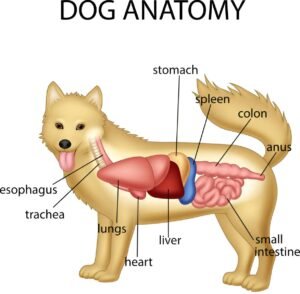Where Is a Dogs Heart? Please put your hands in the space on your dog’s chest right behind their elbows. You will feel it right there—the thump, thump of your dog’s heart, which is one of their most important and tireless organs.
A dog with a healthy heart can run, play, and engage in all of the activities that dogs enjoy. To maintain your dog’s physical health, you must comprehend the structure of the canine heart. Where Is a Dogs Heart? lets dive deeper into deeper!
Where Is a Dogs Heart Positioned within the Body?

The heart of an upright dog is located approximately in the center of the chest, between the lungs. Dogs’ hearts are located in similar locations in general, but breed-specific differences exist, according to Dr. Joanne Harris, a veterinary cardiology specialist at HeartVets in Exeter, UK.
Dr. Harris states that a breed with a barrel-chested chest, such as an English or French Bulldog, will have their heart positioned slightly differently due to their round chest. “However, all of this is more upright if you have a narrow, deep-chested breed (such as a Whippet, Doberman, or Boxer).”If you ever need to do CPR on a dog, knowing where its heart is located might come in handy.
Dogs can receive external cardiac massages in the same manner as humans. “With such narrow-chested breeds, it’s simpler because you don’t have just to exert downward pressure; you can go across the heart.”
Dr. Harris asserts that she does not advise anyone who is not properly trained to administer CPR on dogs. She notes, for starters, that dogs don’t typically have heart attacks since they don’t develop coronary artery disease like people do, making instances in which CPR is necessary infrequent. Second, she asserts that it is simple to misinterpret a scenario in which a dog needs CPR.
According to Dr. Harris, “I would argue that fainting is the most common reason for dogs suddenly collapsing and appearing to have no heartbeat and that at that panicked moment, some dog owners may struggle to feel a heartbeat.” However, unless they have received training in CPR, it is not advised that they attempt CPR in that situation. If you want to know Where Is a Dogs Heart , Anatomy of the dog heart, dog heart care, tips and many more suggestions then Hold us tight!
Anatomy of the Dog Heart: A Closer Look

A dog’s cardiovascular system is made up of an oval-shaped, four-chambered heart and a web of capillaries, arteries, and veins. A dog’s heart pumps blood to its lungs on its right side and the rest of the body on its left.
A dog’s body weight affects how big its heart is. A Chihuahua’s heart will be smaller than a Great Dane’s, according to Dr. Gabrielle Fadl, Bond Vet’s Director of Primary Care. Nonetheless, there is a significant amount of consistency across breeds in the heart’s size about the dog’s size.
Every dog has a blood volume that circulates at roughly 80 milliliters per kilogram of body weight; however, the volume of blood that each dog circulates varies based on their size. According to Dr. Harris, “Blood volume of a Chihuahua might be as little as 400ml, but a Great Dane would have over 6.5 liters.”
What is a dog’s typical heart rate? Research has indicated that the widely held belief that a dog’s body weight influences their heart rate—that is, that smaller dogs have a faster heartbeat than younger canines—may not be accurate. Dogs typically have an average heart rate of 120 beats per minute (bpm), while younger dogs that are under a year old may have a slightly higher heart rate. Furthermore, experts note that dogs who are worried or enthusiastic may have a faster heart rate than calm dogs.
Dog Heart vs. Human Heart
Dog and human hearts are similar anatomically, even though dogs and humans differ greatly from one another physically.
According to Dr. Fadl, “Actually, there are some similarities between the functions of the hearts in humans and dogs. Both have four chambers—the left and right ventricles and the left and right atria—and a similar way of working.” “The aorta, which transports oxygenated blood from the heart to the rest of the body, and the vena cava, which is a large vessel that returns blood to the heart, are two of the larger blood vessels that come directly from the heart and have the same name.”
However, Dr. Fadl notes that there are some significant distinctions between heart diseases in humans and dogs. According to Dr. Fadl, “People frequently develop atherosclerosis, or plaque buildup, in their arteries, which can cause a blockage and a heart attack.” “This kind of problem is not one that dogs typically have.” Rather, a leaky heart valve (which typically develops with age, especially in tiny dogs) or cardiac muscle issues (which are more prevalent in larger breeds) are more frequent causes of them.
Puppy heart murmurs should all be closely watched. While quiet heart murmurs in pups are typically innocuous, they may indicate a congenital cardiac defect if the murmur becomes louder or does not go away by the time the dog is six months old. In pups, heart problems are nearly invariably linked to loud heart murmurs. According to Dr. Harris, If your puppy is identified at a young age with a moderate or loud cardiac murmur, it is best to seek the counsel of a cardiologist and determine whether the puppy needs an echocardiography.”
Congestive heart failure and heartworm disease in regions where it is endemic are two other common cardiac conditions that dogs may experience.
Dog heart care: Where is a dogs heart?
Maintaining a healthy lifestyle and scheduling routine veterinary examinations are two important aspects of caring for a dog’s heart. The following advice can help with dog heart health:
Give your dog a balanced diet: Your dog’s general health, including their heart health, depends on you feeding them a balanced diet. Select premium dog food that is suitable for the size, age, and activity level of your dog. To promote heart health, you might also think about including supplements in their diet, including omega-3 fatty acids.
Frequent visits to the vet: Maintaining the health of your dog’s heart requires routine examinations with your veterinarian. Your dog’s veterinarian may examine the health of its heart, keep an eye out for any potential cardiac issues, and, if required, propose the best course of action. For younger dogs, a yearly checkup is advised, and for older dogs or dogs with a history of heart issues, more frequent checkups are advised.
Preventive care: particular dog breeds are predisposed to particular cardiac diseases, like mitral valve dysfunction or dilated cardiomyopathy. Frequent screenings and blood tests are examples of preventative care that can help identify these illnesses early and offer the right therapy.
Reducing stress: Stress can be detrimental to a dog’s cardiac health. Strive to keep your dog in a peaceful and comfortable environment and steer clear of stressful events, such as abrupt changes in routine or loud noises.
You can keep your dog’s heart healthy and stave off future cardiac issues by adhering to these suggestions.
Frequent exercise: Exercise is essential for keeping dogs’ hearts healthy. Maintaining a healthy weight, strengthening the heart muscle, and lowering the risk of heart disease are all made possible by regular exercise. Before beginning a new exercise program, you should speak with your veterinarian though, since some health issues could need your dog’s exercise regimen adjusted.
Prevention: Dog breeds with a higher risk of developing cardiac diseases such as dilated cardiomyopathy or mitral valve disease should be avoided. Frequent preventive care, including blood tests and screenings, can aid in the early detection of certain illnesses and the provision of the necessary treatment.
You can preserve your dog’s heart health and avert any cardiac issues by paying attention to these pointers and learning about a dog’s heart. Make quick contact with your veterinarian if you observe any symptoms of heart difficulties in your dog, such as coughing, dyspnea, or lethargic behavior.
Dogs’ Heart Health: Important Information
There are numerous things you can do to maintain the best possible health for your dog’s heart.
According to Dr. Fadl, it’s beneficial to maintain a healthy weight to avoid putting too much strain on the heart, lungs, and joints. Even if your dog appears healthy, take them to the recommended veterinary exams. Veterinarians frequently find early warning indicators of illness, such as irregular heart rhythms or sounds (like the ones discussed above), before symptoms appear. An earlier diagnosis typically translates into more affordable and successful therapy. To shield your dog’s heart against these parasites, continue to administer heartworm prevention as prescribed.
Dr. Harris says there is a strong genetic component to many cases of cardiac disease in dogs. Little dogs, such as Chihuahuas, Poodles, Dachshunds, and Cavalier King Charles Spaniels, are more likely to suffer heart valve disease. Dr. Harris advises prospective buyers of breeds susceptible to heart disease to conduct due diligence, learn about screening protocols, and purchase puppies from breeders whose dogs have undergone screening and are declared disease-free.
In addition, Dr. Harris suggests that if a veterinarian finds a heart murmur or irregular heart rhythm in your dog, you take them to a cardiology specialist. Of course, you should also consult a veterinarian if your dog faints, collapses, or exhibits signs like abnormally high levels of fatigue after exercise.
In addition to possibly saving your dog’s life, your prompt action will guarantee that their heart continues to beat as healthily as possible.
How Am I Able to Identify Heart Pain in My Dog?

Since dogs are unable to express their symptoms to us directly, it can be challenging to determine whether they are suffering from heart pain or discomfort. That being said, there are a few indications and indicators you should be aware of that could point to heart trouble in your dog.
Dogs’ Heart Pain Symptoms
Coughing: In dogs, a chronic cough that does not go away may indicate cardiac discomfort. There can be a gagging or retching sound along with this cough.
Breathing Problems: Heart pain may be indicated if your dog is having problems breathing or appears to be breathing more heavily than usual.
Dogs with heart trouble may exhibit restlessness and difficulty finding comfort. They might pace or exhibit restlessness.
Lethargy: Heart-pains dogs may appear worn out or listless. They might not have the same desire to play or stroll as they once had.
Loss of Appetite: Heart discomfort is only one of the many medical conditions that can manifest as a loss of appetite. It might be time to take your dog to the vet if they are not eating or drinking as much as they usually do.
What Should You Do If Your Dog Seems to Be Having Heart Pain?
It’s critical to take your dog to the vet as soon as you suspect that they are suffering from heart trouble. If your dog is having heart pain, your veterinarian can conduct tests and a physical examination. If required, they can also propose a course of treatment.
It’s crucial to keep in mind that canine heart discomfort can be dangerous, even fatal, so if you think your dog may be having heart pain, get them checked out by a veterinarian right away.
Conclusion
In conclusion of Where Is a Dogs Heart?, The heart of a dog is situated in the chest cavity, slightly to the left of the chest’s center, in between the lungs. It is encircled by a membrane known as the pericardium and shielded by the rib cage. The heart’s functions include pumping blood throughout the body, supplying tissues and organs with nutrition and oxygen, and eliminating waste.
Dog owners should know Where Is a Dogs Heart located and how to spot symptoms of heart disease and other heart-related issues. Dogs with heart illness often have coughing fits, breathing problems, lethargy, and weakness. It is crucial to seek veterinarian care as soon as possible if you think your dog might have a cardiac condition.
All in all, by keeping an eye on their dog’s health and seeking timely veterinary attention when needed, owners can help ensure that their pets live happy and healthy lives. This can be achieved by having a better understanding of the anatomy and function of a dog’s heart.
FAQ: Where Is a Dogs Heart?
Where is a dog heart located?
Dogs have their hearts in the spaces in their chests between their lungs. It is situated on the left side of the body, a little bit.
What signs might a dog have of heart pain?
Depending on how severe the disease is, dogs with heart pain may exhibit different symptoms. Coughing, exhaustion, difficulty breathing, and appetite loss are a few common symptoms. It’s critical to take your dog to the vet for an assessment if you observe any of these signs.
Is it possible for a dog to have its heart on its right side?
The right side of the body is a very uncommon location for a dog’s heart. On the other hand, an irregular heart location may result from specific congenital cardiac abnormalities. It’s possible that you can feel your dog’s heartbeat on the right side of their body, but this does not indicate that their heart is located there rather than on the left.
A dog’s cardiac murmur: what is it?
A dog’s heart murmur is an irregular sound detected by a stethoscope while listening to the heart. It is brought on by erratic blood flow inside the heart and may be a sign of a more serious cardiac issue.
